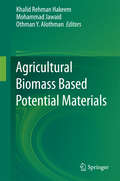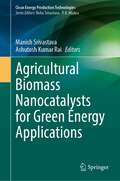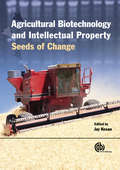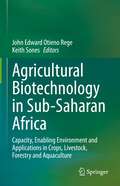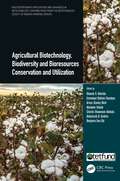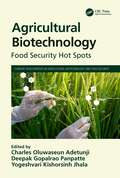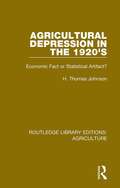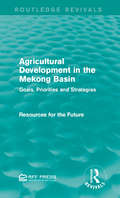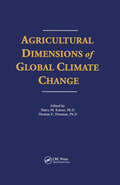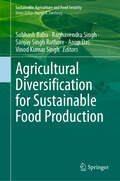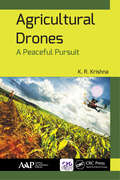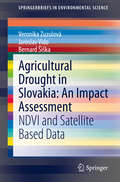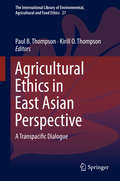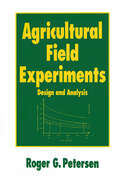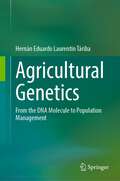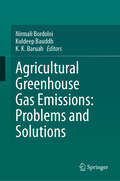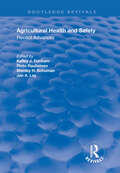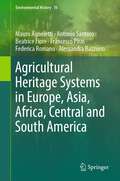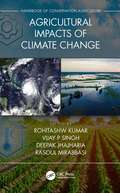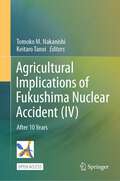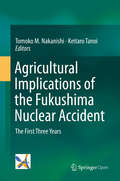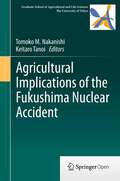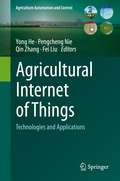- Table View
- List View
Agricultural Biomass Based Potential Materials
by Khalid Rehman Hakeem Mohammad Jawaid Othman Y. AlothmanAgricultural biomass is abundant worldwide and it can be considered as alternative source of renewable and sustainable materials which can be used as potential materials for different applications. Despite this enormous production of agricultural biomass, only a small fraction of the total biomass is utilized for different applications. Industry must be prepared to take advantage of the situation and utilize the available biomass in the best possible manner. Agricultural biomass such as natural fibres has been successfully investigated as a great potential to be used as a renewable and sustainable materials for the production of composite materials. Natural fibres offer excellent specific properties and have potential as outstanding reinforcing fillers in the matrix and can be used as an alternative material for biocomposites, hybrid composites, pulp, and paper industries. Natural fibre based polymer composites made of jute, oil palm, flex, hemp, kenaf have a low market cost, attractive with respect to global sustainability and find increasing commercial use in different applications. Agricultural biomass based composites find applications in a number of fields viz. , automotive industry and construction industry. Future research on agricultural biomass-natural fibre based composites should not only be limited to its automotive applications but can be explored for its application in aircraft components, construction industry, rural housing and biomedical applications. In this book we will cover the chemical, physical, thermal, electrical, and biodegradability properties of agricultural biomass based composite materials and its different potential applications. The main goal of this volume is to familiarize researchers, scientists and engineers with the unique research opportunities and potentials of agricultural biomass based materials. Up-to-date information on alternative biomass utilization Academic and industry leaders discuss unique properties of biomass based composite materials Direct application of agricultural biomass materials as sustainable and renewable alternatives
Agricultural Biomass Nanocatalysts for Green Energy Applications (Clean Energy Production Technologies)
by Manish Srivastava Ashutosh Kumar RaiThe book discusses the various sustainable approaches to combine agrowaste and nanomaterials into catalysts or nanocatalysts with the objective of enhancing biofuel production. It explores the practical sustainability of agronanocatalysts in bioenergy production at a mass scale, while also addressing the existing challenges and proposes sustainable remedies to overcome these limitations. Additionally, the book dives into the cost considerations, recognizing it as a major concern for the widespread utility of catalysts, and explores viable commercial applications in this context.Nanomaterials continue to attract attention in the field of proteins and enzymes due to their versatile physicochemical properties and potential. They offer opportunities to enhance various biofuel production processes by serving as catalysts in the reaction medium. For instance, studies have highlighted the significant improvements in cellulase enzyme production, stability, pretreatment of lignocellulosic biomass, and enzymatic hydrolysis efficiency achieved through the utilization of nanomaterials. The impact of nanomaterials on fermentative hydrogen production has also been documented. While the application of nanomaterials in biofuel production processes has been reported in the literature, there remains a need to focus on the type of nanomaterials, their synthesis, and their specific effects on important process parameters. Addressing and evaluating these factors is crucial to effectively improve and streamline biofuel production processes using nanomaterials. The book serves as a comprehensive introduction to nanomaterials and nanotechnology in biofuel production, catering to the needs of researchers, academicians and students.
Agricultural Biotechnology and Intellectual Property: Seeds of Change
by Jay P. KesanThis volume addresses the intersection of agricultural biotechnology with intellectual property rights (IPRs) from a number of diverse perspectives.
Agricultural Biotechnology in Sub-Saharan Africa: Capacity, Enabling Environment and Applications in Crops, Livestock, Forestry and Aquaculture
by John Edward Otieno Rege Keith SonesThis book offers a comprehensive analysis of the application level for various agricultural biotechnologies across Sub-Saharan Africa. The authors examine the capacity available as well as the enabling environment, including policy and investments, for facilitating agricultural biotechnology development and use in the region. For each Sub-Saharan country, the status of biotechnology application is assessed in four major sectors; Crops, Livestock, Forestry and Aquaculture. Examples such as the number and requisite skill levels of trained personnel, biosafety frameworks and public awareness are surfaced in these chapters. This work also discusses the impact of push-pull factors on research, training and food security and identifies opportunities for investment in biotechnology and local agribusiness.Development partners, policy makers, agricultural consultants as well as scientists and private sector investors with an interest in biotechnology initiatives in Sub-Saharan Africa will find this collection an important account to identify key gaps in capacity and policy, as well as priority areas going forward. The volume highlights ways to develop technology and increase agricultural production capacity through international cooperation and inclusive economic growth, making it a valuable practice guide in line with the UN Sustainable Development Goals, in particular SDG 2 Zero Hunger and SDG 8 Decent Work and Economic Growth. Clear case studies round off the reading experience.
Agricultural Biotechnology, Biodiversity and Bioresources Conservation and Utilization (Multidisciplinary Applications and Advances in Biotechnology)
by Charles Oluwaseun Adetunji Abdulrazak B. Ibrahim Benjamin Ewa Ubi Olawole O. Obembe Abubakar Gidado Emmanuel Olufemi Ekundayo Arinze Stanley OkoliThis book covers a range of important topics on crop and animal genetics, breeding and genomics, as well as biodiversity and genetic resources conservation and utilization reflecting three thematic sections of working groups of the Biotechnology Society of Nigeria. The topics range from agricultural biotechnology, including genetically modified organisms and gene-editing for agronomically important traits in tropical crops, to Nigeria’s mega biodiversity and genetic resources conservation. This book will engender a deeper understanding of underpinning mechanisms, technologies, processes and science–policy nexus that has placed Nigeria as a leader in biotechnology in Africa. The book will be useful reference material for scientists and researchers working in the fields of food and agricultural biotechnology, bioinformatics, plant and animal genetics, breeding and genomics, genetic resources conservation and enhancement. Emphasizes recent advances in biotechnologies that could ameliorate the high-level global food and nutrition insecurity through plant and animal genetics, breeding, as well as genomics Provides detailed information towards harnessing indigenous bioresources for food and nutrition security and climate change adaptation Introduces new frontiers in the area of genomics, most especially their relevant applications in crop and animal breeding Reviews biotechniques that could enhance plant genetic resources conservation and utilization Discusses current biotechnological approaches to exploit genetic resources including the development of synthetic hexaploid wheat (SHW) for crop adaptation to the increasingly changing global climate
Agricultural Biotechnology: Food Security Hot Spots (Current Developments in Agricultural Biotechnology and Food Security)
by Charles Oluwaseun Adetunji Deepak Gopalrao Panpatte Yogeshvari Kishorsinh JhalaThis book presents strategies and techniques highlighting the sustainability and application of microbial and agricultural biotechnologies to ensure food production and security. This book includes different aspects of applications of Artificial Intelligence in agricultural systems, genetic engineering, human health and climate change, recombinant DNA technology, metabolic engineering and so forth. Post-harvest extension of food commodities, environmental detoxification, proteomics, metabolomics, genomics, bioinformatics and metagenomic analysis are discussed as well. Features: Reviews technological advances in microbial biotechnology for sustainable agriculture using Artificial Intelligence and molecular biology approach. Provides information on the fusion between microbial biotechnology and agriculture. Specifies the influence of climate changes on livestock, agriculture and environment. Discusses sustainable agriculture for food security and poverty alleviation. Explores current biotechnology advances in food and agriculture sectors for sustainable crop production. This book is aimed at researchers and graduate students in agriculture, food engineering, metabolic engineering and bioengineering.
Agricultural Biotechnology: Latest Research and Trends
by Pankaj Kumar Ajay Kumar Thakur Dinesh Kumar SrivastavaThis book caters to the need of researchers working in the ever-evolving field of agricultural biotechnology. It discusses and provides in-depth information about latest advancements happening in this field. The book discusses evolution of plant tissue culture techniques, development of doubled haploids technology, role of recombinant-DNA technology in crop improvement. It also provides an insight into the global status of genetically modified crops, use of RNAi technology and mi-RNAs in plant improvement. Chapters are also dedicated for different branches of ‘omics’ science including genomics, bioinformatics, proteomics, metabolomics and phenomics along with the use of molecular markers in tagging and mapping of various genes/QTLs of agronomic importance. This book also covers the role of enzymes and microbes in agriculture in productivity enhancement. It is of interest to teachers, researchers of biotechnology and agriculture scientists. Also the book serves as additional reading material for undergraduate and postgraduate students of biotechnology, agriculture, horticulture, forestry, ecology, soil science, and environmental sciences. National and international biotechnologists and agricultural scientists will also find this to be a useful read.
Agricultural Crop Improvement: Plant and Soil Relationships (Exploring Medicinal Plants)
by Azamal HusenLarger amounts of nutritious food are required to feed the growing world population, which is a great challenge due to water shortages and reduced crop plant yield. To overcome this issue, there must be improvement in crop plant production systems. Agricultural Crop Improvement: Plant and Soil Relationships addresses key issues of crop plant yield and production, with molecular and physiological interventions to evolve future strategies that will overcome these challenges faced by the agricultural sector.Features Investigates modern and traditional agricultural techniques, including nanomaterials, nanosensors, genetic engineering, molecular breeding, nutrient and plant hormone interactions, microbiome engineering, soil enzymes, biostimulants, and intercropping Explores how technologies and scientific advancements from biotechnology, information technology, and environmental science are revolutionizing sustainable farming practices Agricultural Crop Improvement: Plant and Soil Relationships is a valuable source of information for researchers and extension workers involved in sustainable crop plants improvement and practices, and a useful resource for students and scientists working on aspects of agriculture, botany, plant science, crop physiology, crop biotechnology, and microbiology.
Agricultural Depression in the 1920's: Economic Fact or Statistical Artifact? (Routledge Library Editions: Agriculture #1)
by Thomas H. JohnsonFirst published in 1985. This study explores the agricultural depression in the United States of America in the 1920’s. The author examines overproduction, wartime optimism and the farm crisis, and continuity and change in agriculture during this period. This title will be of great interest to students of history, agriculture, and economics.
Agricultural Development in the Mekong Basin: Goals, Priorities and Strategies (Routledge Revivals)
by Resources for the FutureOriginally written for the International Bank for Reconstruction and Development, Resources for the future published this report in 1971 believing it would be of interest to more general readers. Resources for the Future draws on its past experience of resource utilization, development and economics to comment on issues faced by the Mekong Basin River for agricultural development such as the demand-supply conditions for improved agriculture, the limitations imposed by physical and human resource conditions and measures needed to modernize their agricultural methods. This title will be of interest to students of Environmental and Economic studies.
Agricultural Dimensions of Global Climate Change
by Harry Kaiser Thomas DrennenThis important book, written by recognized leaders in their fields, discusses agricultural dimensions of global climate change. Research and policy issues are covered and a multidisciplinary view of global climate change and agriculture is presented. Major sections cover the contribution of agriculture to greenhouse gas (GHG) emissions (including an investigation as to whether monitoring and verification of such emissions would work) and the impact of global climate change on agriculture. The book examines such important issues as global food availability, distributional effects between developing and developed countries, agricultural adaptation possibilities, and whether CO2 enrichment will benefit agriculture. A unique feature of this publication is that it addresses communication difficulties between researchers and policy makers and suggests solutions.
Agricultural Diversification for Sustainable Food Production (Sustainability Sciences in Asia and Africa)
by Anup Das Vinod Kumar Singh Subhash Babu Raghavendra Singh Sanjay Singh RathoreThis book discusses agricultural diversification, nutritional security and environmental sustainability. It helps to address the multipronged challenges of nutritional security while preserving the dwindling natural resources in the current fluctuating climate conditions. Energy-intensive, conventional agricultural production systems accelerate environmental footprints, resource mining, biodiversity losses, and human health problems and reduce soil functionality. Diversified farming can potentially enhance yield, food security, and climate change buffering as it helps to achieve advanced food security by efficient resource use and profit maximization. This book covers the challenges faced during the adoption of diversified farming and opportunities to enhanced food production and minimize the environmental footprints. This book is useful for academicians, researchers, ecologists, environmentalists, students, capacity builders, and policymakers to have in-depth knowledge of this complex and diverse field. This book also helps in devising a road map for policy planning and advancement of existing knowledge for various stakeholders working in this field.
Agricultural Drones: A Peaceful Pursuit
by K. R. KrishnaAgricultural drones are expected to revolutionize the way we conduct agronomic procedures and maintain natural vegetation on earth. This book explores the increasing importance of the role of aerial robots in managing agricultural farms and natural resources. Agricultural Drones: A Peaceful Pursuit provides a wealth of information on drone usage in agriculture. The book discusses the advanced sensors and imaging capabilities of drones that give farmers new ways to increase yields and reduce crop damage. An introductory chapter provides historical data, with details about various models of drones as well as the most recent and popular agricultural drones in usage. The book goes onto look at such topics as the use of drones for soil fertility, production agronomy, irrigation, weed control, pest and disease control, grain yield forecasting, and economic advantages from drone use. This timely and useful volume will be a valuable resource for faculty, agricultural extension officers, and farmers and farm consultancy agencies. This book would also serve as an excellent textbook for students in agriculture, engineering, geography, etc. Key features: • outlines the advantages of using drones in agriculture, such as for the management of soil fertility, the study of natural resources and vegetation, the maintenance of adequate irrigation, and the control of weeds and pests • covers the economic advantages of using drones in agriculture • examines the regulatory aspects of agricultural drones • provides actual examples of drone usage in agriculture
Agricultural Drought in Slovakia: NDVI and Satellite Based Data (SpringerBriefs in Environmental Science)
by Veronika Zuzulová Jaroslav Vido Bernard ŠiškaThis book gives an insight into the evaluation of drought in Slovakia and provides an assessment of Normalized Difference Vegetation Index (NDVI) as a method suitable for an evaluation of drought in agricultural land. Dry seasons in the time series from 1960 to 2014 were determined according to the monthly Palmer Drought Severity Index (PDSI). The field research was carried out on 12 sites including western Slovakia, Prešov, Trnava and Nitra regions. Data collected from satellite imagery, climate data analyses and drought indices was analysed to determine the value of NDVI as an evaluation tool.
Agricultural Ethics in East Asian Perspective: A Transpacific Dialogue (The International Library of Environmental, Agricultural and Food Ethics #27)
by Paul B. Thompson Kirill O. ThompsonThis book brings together agricultural ethics scholars from the US, Japan and Taiwan to discuss crucial issues in agricultural ethics and sustainability ethics in comparative context. Agricultural ethics and sustainability ethics are wide-ranging and closely linked to environmental ethics, bioethics, virtue ethics, animal welfare, soil conservation, not to mention rural traditions and lifestyles. Six of the chapters cover historical traditions and values in Europe, the US and East Asia. Four of the chapters cover the role of virtue ethics in the analysis of agrarian and environmental ethics, agricultural biotechnology, food ethics, and alternative agriculture, respectively. Finally, two of the chapters cover field efforts of agricultural ethics involving preserving agricultural heritage and building consensus for sustainable farming, respectively. Although the papers are divided into three groups, their contents are interconnected and mutually informative.
Agricultural Field Experiments: Design and Analysis (Books in Soils, Plants, and the Environment #Vol. 31)
by Roger G. PetersenThis text provides statistical and biometrical procedures for designing, conducting, analyzing and interpreting field experiments. It addresses the most important research topics in agriculture, including agronomy, breeding and pasture trials; farming systems research; and intercropping research.
Agricultural Genetics: From the DNA Molecule to Population Management
by Hernán Eduardo Laurentin TáribaReaders will find in this book a comprehensive text on the intersection of genetic and agriculture, addressing the different levels at which DNA is studied for agricultural purposes. The different subdivisions of genetics (molecular, Mendelian, quantitative and populations) are all discussed in the light of agriculture research and practice. Agricultural Genetics aims to be a support for advanced and undergraduate students taking courses on biology, genetics and breeding applied to agriculture, both for plant sciences and animal sciences.
Agricultural Greenhouse Gas Emissions: Problems and Solutions
by Kuldeep Bauddh Nirmali Bordoloi K. K. BaruahThis book collects information on greenhouse gas (GHG) emissions, especially from the agro-ecosystems. It highlights the GHG emission mitigation measures using environmentally viable and cost-effective technologies. The title deals with the evaluation of the emission of GHGs from different agriculture sources, estimates the emission trends, analyzes the affecting drivers and assesses the feasible and suitable mitigation options for local farmers. Agricultural activities including land clearing, crop cultivation, fertilizer application, irrigation pattern, animal husbandry and fisheries have a significant impact on GHG production and emissions. The application of excess amount of inorganic fertilizer to increase the crop production may also boost the emissions of GHGs from agricultural fields. Therefore, it is urgent to concurrently quantify the fluxes of GHGs, improve understanding of gaseous emissions from different agricultural sources and to develop mitigation strategies to reduce the future climate chaos. This book is of interest to the farmers, horticulturists, scientists, ecologists, and a valuable source of reference to the relevant researchers and students in the region. Also, the book serves as additional reading material for undergraduate and graduate students of environmental science, agriculture, animal husbandry, ecology and soil science.
Agricultural Health and Safety: Recent Advances
by Kelley J. Donham Risto Rautiainen Stanley H Schuman Jan LayProtect yourself from machinery accidents, skin cancer, pesticide exposure, and so much more!Maintaining safety on the farm is a greater challenge than ever. Farmers are trying to expand their farm size and increase production while coping with labor shortages, adverse weather, and equipment problems. Agricultural Health and Safety gives you an in-depth look at these issues and presents effective new approaches to intervention and education for farm health and safety problems. Agricultural Health and Safety discusses new research, education, and prevention programs that have been tested from Maine to California and from Australia to Sweden. These important scientific and analytical studies were presented at the 1996 National Institute for Occupational Safety and Health Conference in Iowa. In addition to suggesting new ways to deal with the recognized physical hazards of farming, Agricultural Health and Safety discusses the often neglected role of mental health. It examines the role of stress in causing accidents and the risks of depression and suicide among agricultural workers. Agricultural Health and Safety considers a broad range of problems and effective interventions, including: insurance incentives for safe farms accident-prevention programs training for responding to farm emergencies cutting the risks of accident for farm children the ergonomics of milking teaching farm youth about sun safety the risks of exposure to pesticides, fertilizers, and other environmental hazardsAgricultural Health and Safety offers practical information on the broad spectrum of health and safety hazards in the farm setting and outlines effective strategies for eliminating them. In addition, it opens new avenues for further study and research. This comprehensive book is an essential resource for agricultural safety and health researchers, program professionals, health care providers in farming communities, professors and students in agromedicine and agricultural programs, and agricultural workers.
Agricultural Heritage Systems in Europe, Asia, Africa, Central and South America (Environmental History #16)
by Mauro Agnoletti Antonio Santoro Beatrice Fiore Francesco Piras Federica Romano Alessandra BazzurroAgriculture is often considered as one of the main threats to ecosystems. Unsustainable farming practices often result in habitat loss, inefficient use of water, soil degradation, pollution, genetic erosion, among other negative impacts on human life, including hunger, low food quality, reduced access to food resources, as well as the abandonment of rural areas. Nevertheless, when agriculture is practiced in a sustainable way, it can contribute to the preservation of many habitats, to the protection of watersheds, to the preservation and improvement of soil health.The use of sustainable and ecological practices is the key feature distinguishing traditional agriculture from intensive one. It may not provide very high yields, but ensures sustainable harvests over time, thanks to time-tested technologies and traditional know-hows and also represent examples of adaptation to harsh environmental conditions. Based on this approach, in 2002, FAO launched the concept of Globally Important Agricultural Heritage Systems (GIAHS) Programme, to identify and safeguard agricultural systems that are ensuring food and livelihood security, while maintaining magnificent landscapes, agricultural biodiversity, traditional knowledge, cultural and social values.This book presents 18 examples of these traditional agriculture systems around the world, with a special focus on Europe, Asia, Africa, Central and South America, as a result of the “GIAHS Building Capacity” project co-funded by the Italian Agency for Development Cooperation (AICS) and carried out by the Department of Agriculture, Food, Environment and Forestry (DAGRI) of the University of Florence (Italy).
Agricultural Impacts of Climate Change [Volume 1]
by Vijay P. Singh Rohitashw Kumar Deepak Jhajharia Rasoul MirabbasiConservation agriculture is a sustainable production model that not only optimizes crop yields, but also reaps economic and environmental benefits as well. The adoption of successful conservation agriculture methods has resulted in energy savings, higher organic matter content and biotic activity in soil, increased crop-water availability and thus resilience to drought, improved recharge of aquifers, less erosion, and reduced impacts from the weather associated with climate change in general. Agricultural Impacts of Climate Change examines several important aspects of crop production, such as climate change, soil management, farm machinery, and different methods for sustainable conservation agriculture. It presents spatial distribution of a daily, monthly and annual precipitation concentration indices, Diffuse Reflectance Fourier Transform Infrared Spectroscopy for analyzing the organic matter in soil, and adaptation strategies for climate-related plant disease scenarios. It also discusses solar energy-based greenhouse modeling, precision farming using remote sensing and GIS, and various types of machinery used for conservation agriculture. Features: Examines the effects of climate change on agriculture and the related strategies for mitigation through practical, real-world examples Explores innovative on-farm technology options to increase system efficiency resulting in improved water usage Presents examples of precision farming using climate-resilient technologies
Agricultural Implications of Fukushima Nuclear Accident (IV): After 10 Years
by Keitaro Tanoi Tomoko M. NakanishiThis open access book presents the findings from on-site research into radioactive cesium contamination in various agricultural systems affected by the Fukushima Daiichi Nuclear Power Plant accident in March 2011. This fourth volume in the series reports on studies undertaken at contaminated sites such as farmland and forests, focusing on soil, water, mountain, agricultural products, and animals. It also provides additional data collected in the subsequent years to show how the radioactivity levels in agricultural products and their growing environments have changed with time and the route by which radioactive materials entered agricultural products as well as their movement between different components (e.g., soil, water, and trees) within an environmental system (e.g., forests). The book covers various topics, including radioactivity testing of food products; decontamination trials for rice and livestock production; the state of contamination in, trees, mushrooms, and timber; the dynamics of radioactivity distribution in paddy fields and upland forests; damage incurred by the forestry and fishery industries; and the change in consumers’ attitudes. In the series of this book, a real-time radioisotope imaging system has been introduced, a pioneering technique to visualize the movement of cesium in soil and in plants. This is the only book to provide systematic data on the actual change of radioactivity, which is of great value to all researchers who wish to understand the effect of radioactive fallout on agriculture. In addition, it helps the general public better understand radio-contamination issues in the environment. The project is ongoing; the research groups from the Graduate School of Agricultural and Life Sciences of The University of Tokyo continue their work in the field further to evaluate the long-term effects of the Fukushima accident.
Agricultural Implications of the Fukushima Nuclear Accident: The First Three Years
by Keitaro Tanoi Tomoko M. NakanishiFollowing the Fukushima nuclear accident, a large volume of monitoring data has been collected about the soil, air, dust, and seawater, along with data about an immense number of foods supplied to the market. Little is known, however, about the effect of radioactive fallout on agriculture, information about which is vital. Although more than 80% of the damaged area is related to agriculture, in situ information specifically for agriculture is scarce. This book provides data about the actual movement and accumulation of radioactivity in the ecological system--for example, whether debris deposited on mountains can be a cause of secondary contamination, under what conditions plants accumulate radioactive cesium in their edible parts, and how radioactivity is transferred from hay to milk. Because agriculture is so closely related to nature, many specialists with different areas of expertise must be involved in answering these questions. In the case of rice, researchers in rice cultivation as well as in soil, hydrology, and radioactivity measurement are working together to reveal the paths or accumulation of radioactivity in the field. For this purpose, the Graduate School of Agricultural and Life Sciences of The University of Tokyo has diverse facilities available throughout Japan, including farmlands, forests, and meadowlands. Many academic staff members have formed groups to conduct on-site research, with more than 40 volunteers participating. This book presents the data collected from the only project being systematically carried out across Japan after the Fukushima accident.
Agricultural Implications of the Fukushima Nuclear Accident: The First Three Years
by Keitaro Tanoi Tomoko M. NakanishiFollowing the Fukushima nuclear accident, a large volume of monitoring data has been collected about the soil, air, dust, and seawater, along with data about an immense number of foods supplied to the market. Little is known, however, about the effect of radioactive fallout on agriculture, information about which is vital. Although more than 80% of the damaged area is related to agriculture, in situ information specifically for agriculture is scarce. This book provides data about the actual movement and accumulation of radioactivity in the ecological system—for example, whether debris deposited on mountains can be a cause of secondary contamination, under what conditions plants accumulate radioactive cesium in their edible parts, and how radioactivity is transferred from hay to milk. Because agriculture is so closely related to nature, many specialists with different areas of expertise must be involved in answering these questions. In the case of rice, researchers in rice cultivation as well as in soil, hydrology, and radioactivity measurement are working together to reveal the paths or accumulation of radioactivity in the field. For this purpose, the Graduate School of Agricultural and Life Sciences of The University of Tokyo has diverse facilities available throughout Japan, including farmlands, forests, and meadowlands. Many academic staff members have formed groups to conduct on-site research, with more than 40 volunteers participating. This book presents the data collected from the only project being systematically carried out across Japan after the Fukushima accident.
Agricultural Internet of Things: Technologies and Applications (Agriculture Automation and Control)
by Fei Liu Qin Zhang Yong He Pengcheng NieInternet of things (IoT) is a new type of network that combines communication technology, expanded applications, and physical devices. Among them, agriculture is one of the most important areas in the application of the IoT technology, which has its unique requirements and integration features. Compared to the information technology in traditional agriculture, the agricultural IoT mainly refers to industrialized production and sustainable development under relatively controllable conditions. Agricultural IoT applies sensors, RFID, visual capture terminals and other types of sensing devices to detect and collect site information, and with broad applications in field planting, facility horticulture, livestock and poultry breeding, aquaculture and agricultural product logistics. It utilizes multiple information transmission channels such as wireless sensor networks, telecommunications networks and the internet to achieve reliable transmission of agricultural information at multiple scales and intelligently processes the acquired, massive information. The goals are to achieve (i) optimal control of agricultural production process, (ii) intelligent electronic trading of agricultural products circulation, and (iii) management of systematic logistics, quality and safety traceability. This book focuses on three levels of agricultural IoT network: information perception technology, information transmission technology and application technology.
